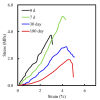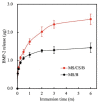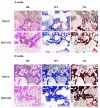Incorporation of Calcium Sulfate Dihydrate into a Mesoporous Calcium Silicate/Poly-ε-Caprolactone Scaffold to Regulate the Release of Bone Morphogenetic Protein-2 and Accelerate Bone Regeneration
- PMID: 33572786
- PMCID: PMC7911692
- DOI: 10.3390/biomedicines9020128
Incorporation of Calcium Sulfate Dihydrate into a Mesoporous Calcium Silicate/Poly-ε-Caprolactone Scaffold to Regulate the Release of Bone Morphogenetic Protein-2 and Accelerate Bone Regeneration
Abstract
Tissue engineering and scaffolds play an important role in tissue regeneration by supporting cell adhesion, proliferation, and differentiation. The design of a scaffold is critical in determining its feasibility, and it is critical to note that each tissue is unique in terms of its morphology and composition. However, calcium-silicate-based scaffolds are undegradable, which severely limits their application in bone regeneration. In this study, we developed a biodegradable mesoporous calcium silicate (MS)/calcium sulfate (CS)/poly-ε-caprolactone (PCL) composite and fabricated a composite scaffold with 3D printing technologies. In addition, we were able to load bone morphogenetic protein-2 (BMP-2) into MS powder via a one-step immersion procedure. The results demonstrated that the MS/CS scaffold gradually degraded within 3 months. More importantly, the scaffold exhibited a gradual release of BMP-2 throughout the test period. The adhesion and proliferation of human dental pulp stem cells on the MS/CS/BMP-2 (MS/CS/B) scaffold were significantly greater than that on the MS/CS scaffold. It was also found that cells cultured on the MS/CS/B scaffold had significantly higher levels of alkaline phosphatase activity and angiogenic-related protein expression. The MS/CS/B scaffold promoted the growth of new blood vessels and bone regeneration within 4 weeks of implantation in rabbits with induced critical-sized femoral defects. Therefore, it is hypothesized that the 3D-printed MS/CS/B scaffold can act both as a conventional BMP-2 delivery system and as an ideal osteoinductive biomaterial for bone regeneration.
Keywords: 3D printing; bone morphogenetic protein-2; calcium silicate; calcium sulfate; osteogenesis.
Conflict of interest statement
The authors declare no conflict of interest.
Figures












Similar articles
-
Enhanced Capability of Bone Morphogenetic Protein 2-loaded Mesoporous Calcium Silicate Scaffolds to Induce Odontogenic Differentiation of Human Dental Pulp Cells.J Endod. 2018 Nov;44(11):1677-1685. doi: 10.1016/j.joen.2018.08.008. J Endod. 2018. PMID: 30409449
-
Mechanical assessment and odontogenic behavior of a 3D-printed mesoporous calcium silicate/calcium sulfate/poly-ε-caprolactone composite scaffold.J Formos Med Assoc. 2022 Feb;121(2):510-518. doi: 10.1016/j.jfma.2021.06.025. Epub 2021 Jul 12. J Formos Med Assoc. 2022. PMID: 34266707
-
The synergistic effects of graphene-contained 3D-printed calcium silicate/poly-ε-caprolactone scaffolds promote FGFR-induced osteogenic/angiogenic differentiation of mesenchymal stem cells.Mater Sci Eng C Mater Biol Appl. 2019 Nov;104:109887. doi: 10.1016/j.msec.2019.109887. Epub 2019 Jun 24. Mater Sci Eng C Mater Biol Appl. 2019. PMID: 31500024
-
The synergistic effects of quercetin-containing 3D-printed mesoporous calcium silicate/calcium sulfate/poly-ε-caprolactone scaffolds for the promotion of osteogenesis in mesenchymal stem cells.J Formos Med Assoc. 2021 Aug;120(8):1627-1634. doi: 10.1016/j.jfma.2021.01.024. Epub 2021 Feb 13. J Formos Med Assoc. 2021. PMID: 33593691
-
Biomimetic Scaffolds of Calcium-Based Materials for Bone Regeneration.Biomimetics (Basel). 2024 Aug 24;9(9):511. doi: 10.3390/biomimetics9090511. Biomimetics (Basel). 2024. PMID: 39329533 Free PMC article. Review.
Cited by
-
A Novel One-Pot Synthesis and Characterization of Silk Fibroin/α-Calcium Sulfate Hemihydrate for Bone Regeneration.Polymers (Basel). 2021 Jun 18;13(12):1996. doi: 10.3390/polym13121996. Polymers (Basel). 2021. PMID: 34207134 Free PMC article.
-
Bidirectional Differentiation of Human-Derived Stem Cells Induced by Biomimetic Calcium Silicate-Reinforced Gelatin Methacrylate Bioink for Odontogenic Regeneration.Biomedicines. 2021 Jul 31;9(8):929. doi: 10.3390/biomedicines9080929. Biomedicines. 2021. PMID: 34440133 Free PMC article.
-
Biofabrication of Gingival Fibroblast Cell-Laden Collagen/Strontium-Doped Calcium Silicate 3D-Printed Bi-Layered Scaffold for Osteoporotic Periodontal Regeneration.Biomedicines. 2021 Apr 16;9(4):431. doi: 10.3390/biomedicines9040431. Biomedicines. 2021. PMID: 33923505 Free PMC article.
-
Biomimetic approaches and materials in restorative and regenerative dentistry: review article.BMC Oral Health. 2023 Feb 16;23(1):105. doi: 10.1186/s12903-023-02808-3. BMC Oral Health. 2023. PMID: 36797710 Free PMC article. Review.
-
The Development of Light-Curable Calcium-Silicate-Containing Composites Used in Odontogenic Regeneration.Polymers (Basel). 2021 Sep 15;13(18):3107. doi: 10.3390/polym13183107. Polymers (Basel). 2021. PMID: 34578012 Free PMC article.
References
-
- Wang W.C., Nune K.C., Tan L., Zhang N., Dong J., Yan J., Misra R.D.K., Yang K. Bone regeneration of hollow tubular magnesium-strontium scaffolds in critical-size segmental defects: Effect of surface coatings. Mater. Sci. Eng. C Mater. Biol. Appl. 2019;100:297–307. doi: 10.1016/j.msec.2019.02.067. - DOI - PubMed
-
- Gómez-Lizárraga K.K., Flores-Morales C., Del Prado-Audelo M.L., Álvarez-Pérez M.A., Piña-Barba M.C., Escobedo C. Polycaprolactone- and polycaprolactone/ceramic-based 3D-bioplotted porous scaffolds for bone regeneration: A comparative study. Mater. Sci. Eng. C Mater. Biol. Appl. 2017;79:326–335. doi: 10.1016/j.msec.2017.05.003. - DOI - PubMed
LinkOut - more resources
Full Text Sources
Other Literature Sources

